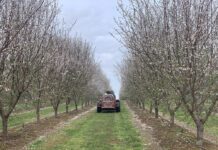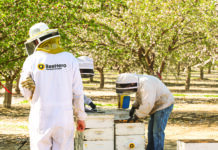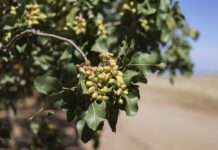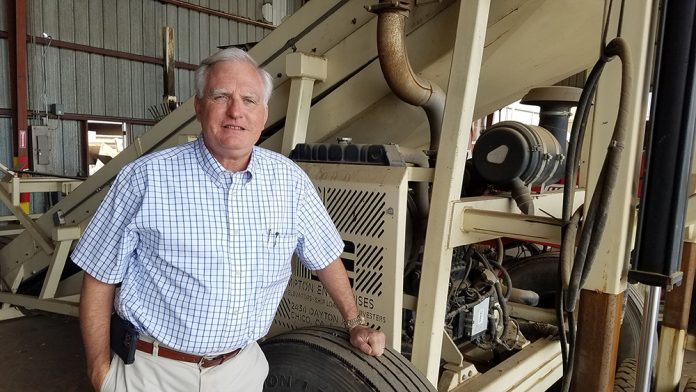
While acknowledging that growers are coming off difficult times in the almond and walnut industry, handlers and industry leaders recently expressed optimism for the coming season.
“That optimism comes from us saying we’ve hit rock bottom and the only way to go is up,” John Rodriguez, grower relations manager with Mariani Nut Company, said half-jokingly.
In fact, he and others noted, after a devastating season for many walnut growers, indicators for the upcoming crop and marketing outlook were very positive.
Prolonged heavy rains and a deep snowpack last winter have helped recharge aquifers and reservoirs in California and a deep winter chill followed by ideal spring conditions have all led to a forecast for excellent crop quality. At the same time, some of California’s leading competitors in the world market, including Chile, will be running out of supply, opening channels for California walnuts.
“This year, our trees are more capable of handling higher temperatures than the previous years when the trees were under stress due to long-term deficit irrigation,” commented fourth-generation grower and handler Bill Carriere of Glenn, Calif. “Long-time growers have commented that the trees have not looked this strong and healthy in at least six to seven years. The full leaf canopy provided excellent temperature control and sun protection during the spring and summer months, allowing the walnuts to grow evenly with minimal sunburn. I am very optimistic that this year will mark a return to the premium quality walnuts we are known for in California.”
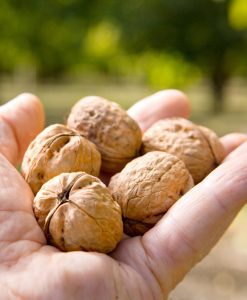
Like many growers, Don Barton this year pulled acreage of legacy walnuts in light of sinking markets. This reflects a natural shift in acreage following the market downturn.
While acknowledging the pain of removing a productive orchard, he noted “things are looking more hopeful going into the 2023 harvest season.
Last year was characterized by record carryover, a large crop, a strong dollar and a clogged pipeline, Barton noted. This year has been flipped on its head, creating a much better outlook for 2023-24.
Barton said carryover is heading in the right direction, surveys reveal a more balanced supply of high-quality California walnuts, and the dollar has dropped 10 percent from last year, all creating strong pull for new crop walnuts from California.
“As rough as 2022-23 was, 2023-24 is certainly looking more promising,” he said.
An acreage survey conducted by the California Walnut Board between October 2022 and July 2023 revealed for the first time ever that the acreage of California walnuts declined, with 23,000 acres removed during the nine-month period. The industry will likely see additional reductions between July and December 2023, as more growers decide to shift to other crops.
According to the Walnut Board, even with the removal of these orchards, the industry has a strong production base with approximately 380,000 producing acres and 37,000 younger non-bearing acres.
“[In August] the California Walnut Board released the monthly and year-to-date shipment report which highlighted an additional reason why I am bullish about the upcoming season,” remarked Martin Mariani, a grower/processor from Winters, California, “The data shows that we have shipped the equivalent of 730,488 tons this season from an available inventory of 880,000 tons.”
He went on to explain that when taking into consideration the high sales commitments going into the fall, “we are virtually sold out of available inventory, which bodes well for the industry. I can’t wait to bring the new crop to market.”
With a focus on inshell markets, Chile is anticipated to be sold out by the time the new California crop starts shipping this fall, the board reported. With minimal inventories of export-quality walnuts on hand, coupled with the current limited supply of walnut halves in global markets, the fresh California crop of premium quality walnuts, inshell and kernels, will be in high demand.
“Domestically, sales have increased 28% which helped our industry work through the high inventory numbers we saw at the start of the season” said Mike Poindexter of Poindexter Nut Company in Selma, California. “Major US retailers significantly increased their promotional efforts, which stimulated consumer sales. This is continuing through the fall and will provide nice momentum going into the U.S. holiday season for new crop kernels and inshell sales.”
Acknowledging the difficulty California walnut industry growers have faced in recent years, Robert Verloop, CEO and Executive Director for the California Walnut Commission (CWC) and Board, said the organization is working to secure emergency relief for walnut growers.
“Also, working with the CWC Board of Directors, industry handlers/processors, many volunteer leaders and elected officials and regulators, we have successfully secured a record USDA Section 32 purchase this season for up to $90 million,” Verloop said. “This funding is being used to help move the current crop out of our storage and into 1,400 food banks across the U.S., providing additional nutrition to thousands of families. In addition, the 20% reduction in tariffs recently announced by India will help us regain our footing in the Indian market.”
Mike Kelley, president of the central California Almond Growers Association, a cooperative huller/sheller made up of 350 smaller growers, said that despite its difficulties the almond industry still has an excellent story to tell in terms of its quality and health benefits that will keep propelling California forward.
“This industry is going to be around for a long time. We are blessed to have an environment here that is conducive to growing almonds and we produce a crop that provides excellent health benefits to consumers,” Kelley said.







